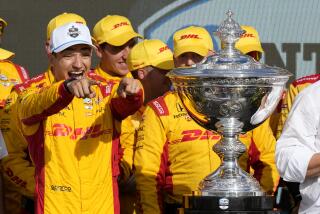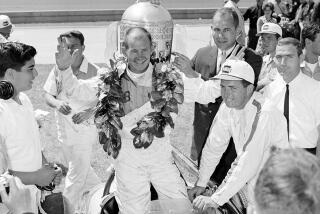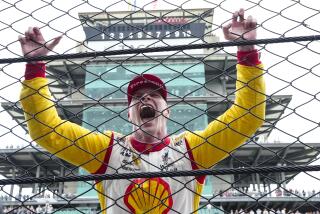For Some, Finish Was Worth Its Wait in Gold
FONTANA — It sort of figures that a 500-mile race that starts--OK, restarts--at 10 a.m. on a non-holiday Monday is going to be a little unusual.
The Marlboro 500 at California Speedway more than lived up to those expectations.
As Roger Penske, the car owner for whom driver Gil de Ferran won the season championship and the $1-million bonus that went with it, so aptly observed, “There was a lot going on out there today.”
CART’s season finale was a very good race--easily the most competitive champ car race in the four-year history of the two-mile superspeedway--but it was also a very strange one.
For one thing, this very good race was witnessed by, comparatively speaking, a very small crowd. Ordinarily, somewhere in the neighborhood of 90,000 people drop in on this exercise in speed and endurance. But because it had rained Sunday, forcing a suspension of the proceedings until a non-holiday Monday morning, maybe half that many returned.
For another, this very good race, which produced 59 official lead changes and probably 100 unofficial ones in some of the best racing anyone could hope for, ended with only six cars in the 26-car field running--and with the yellow caution flag flying.
That was because the car driven by Alex Tagliani, a car that never figured to be in third place with two laps to go, blew an engine while running third with two laps to go. And that blowup was the last of an epidemic of blown engines that tempered the high-speed, wheel-to-wheel racing with 11 caution periods over 85 of the 250 laps.
You want more?
How about Alex Barron, a part-timer driving in only his sixth CART race this season, challenging for the lead with 11 laps left? Of course, he didn’t make it because his car’s engine blew with 10 laps left.
How about De Ferran, with the fastest car in the field--he’d qualified on the pole Saturday--running an ultra-conservative race so that his car’s engine wouldn’t blow and still finishing third?
How about Casey Mears, an Indy Lights driver making his champ car debut, finishing fourth? And he might have been third, had he not bobbled on a late-race restart.
How about such stalwarts as Juan Montoya, Michael Andretti, Dario Franchitti, Jimmy Vasser, Helio Castroneves, Paul Tracy, Kenny Brack and Max Papis not finishing at all?
Or winner Christian Fittipaldi casually referring to second-place finisher and fellow Brazilian Roberto Moreno as “Bob” at the post-race news conference?
“Who’s Bob?” asked a bemused Moreno, who earlier had ventured that his second-place finish was mostly good fortune because he hadn’t been driving a second-place car. And that he had finished on a flat tire--”completely flat.”
Strange stuff.
So what was going on here?
First, there was the race distance. Fuel-economy figures strongly into any 500-mile race, and it seemed to figure more strongly than usual in this one. De Ferran drove a conservative race but so, to hear them tell it, did Fittipaldi and Vasser and any number of others. That, strange as it may sound, led to much of the passing.
“It seemed like nobody wanted to lead,” Fittipaldi said.
So, at speeds of more than 230 mph, drivers passed the lead back and forth, using the draft to conserve fuel when it suited them.
Brack, for instance, still had a shot at the championship when the race was restarted but had to win the race after having led the most laps--provided De Ferran scored no points. It was important for Brack, therefore, to lead as many laps as he could, and still, somehow, conserve fuel.
So, in the early going, he and Castroneves, who was thinking of winning the other $1 million for Penske by winning the race, settled into an entertaining little routine. Brack would ride Castroneves’ draft down the backstretch, pass for the lead going into Turn 3 and cross the line ahead, then tuck back into Castroneves’ draft again in Turn 1.
It would have been great for both if they had been able to keep it going all race long but. . . .
Brack was taken out because of a faulty turbocharger, and Castroneves crashed after his car had fallen victim to the blown-engine syndrome.
Which leads to the second major factor.
No one can say for sure, but the rain delay might have been responsible for some of the rampant engine failure. Racing engines are temperamental critters that run best without interruption. There was nearly a 24-hour interruption in this case. They also run best in just-right temperatures. It was downright chilly Monday, colder than it had been Sunday.
And finally, because of the concern for fuel economy, most drivers were running a “full lean” fuel setting, meaning the engines were slowly being starved, which makes them cranky--and brittle.
What it all added up to was a very good, very strange race that could have finished spectacularly.
Fittipaldi had it figured.
“I knew it would come down to the last 10-15 laps,” he said. “At the end, I had my car running wide open. I couldn’t go any quicker than that.”
And Moreno said, “I was setting myself up to pass Christian [at the end]. I didn’t have a car faster, but if I could get in his slipstream, I might have made it.”
Then Tagliani’s car blew and crashed. Yellow flag. End of strange race. End of season.
More to Read
Go beyond the scoreboard
Get the latest on L.A.'s teams in the daily Sports Report newsletter.
You may occasionally receive promotional content from the Los Angeles Times.










